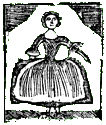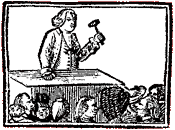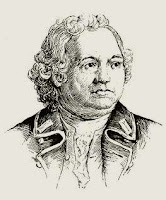“Persons Suspected of Being Inimical”
 According to Caleb Butler’s 1848 recounting of how Prudence Wright and the women of Pepperell arrested Leonard Whiting in April 1775, that New Hampshire man “was in reality the bearer of despatches from Canada to the British in Boston.” Butler reported that Whiting’s “despatches were sent to the Committee of Safety,” created by the Massachusetts Provincial Congress to coordinate the armed resistance.
According to Caleb Butler’s 1848 recounting of how Prudence Wright and the women of Pepperell arrested Leonard Whiting in April 1775, that New Hampshire man “was in reality the bearer of despatches from Canada to the British in Boston.” Butler reported that Whiting’s “despatches were sent to the Committee of Safety,” created by the Massachusetts Provincial Congress to coordinate the armed resistance.
In An Account of Some of the Early Settlers of West Dunstable, Monson, and Hollis (1915), Charles S. Spaulding wrote of Whiting, “He was detected while carrying treasonable despatches from Canada to Boston to the British officers, by the women of Pepperell…”
Yet the published records of the Committee of Safety don’t mention Whiting, or important intercepted messages from Canada. No researcher appears to have turned up those “treasonable dispatches” in the Massachusetts archives. We do have a short 24 Apr 1775 letter to the Committee of Safety from Oliver Prescott of Groton, the man who reportedly examined Whiting after his arrest, but it says nothing about a prisoner.
Whiting and his associates were definitely under suspicion. On 13 July, a Hillsborough County congress investigated his brother Benjamin, considering depositions from Robert Fletcher and Thompson Maxwell. That body concluded that Benjamin was “an open and avowed enemy to his country,” and cautioned “persons from connexions with him.”
In spring 1776, according to Samuel T. Worcester’s History of the Town of Hollis, local committees of safety and then the New Hampshire assembly summoned the Whiting brothers and Samuel and Thomas Cumings as “persons suspected of being inimical to the Rights and Liberties of the United Colonies.” (This means Thomas Cumings could not have left the area forever immediately after meeting his sister at the Pepperell bridge, as one later tradition claimed.)
In June both chambers of the New Hampshire legislature agreed:
That the said Suspicion is not sufficiently Supported, and that the said Leonard Whiting, Benjamin Whiting, Samuel Cummings, and Thomas Cummings be acquitted & fully Discharged.But soon the courts indicted Thomas Cumings on a new charge. He forfeited his bail and left the state. Samuel Cumings and Benjamin Whiting followed, and New Hampshire confiscated their property.
Only Leonard Whiting remained in America, but that same local history says, “for a large portion of the years 1777 and 1778 he was imprisoned in the jail at Amherst, with several other accused persons.” Finally, he was released, and returned to the community, regaining a measure of respect by the time he died.
If Leonard Whiting had indeed been caught carrying “treasonable dispatches” in April 1775, it’s hard to believe that the Patriot authorities who kept locking him up between then and 1778 didn’t have enough evidence to convict him.
I think it likely that at some point in 1775-76 the Pepperell women did stop Whiting at the Nashua River bridge and take him to Prescott, the local Patriot organizer. (As for whether Samuel Cumings was along for the ride, the evidence for that is weaker.) Whiting may even have been carrying letters of some sort, and the locals, already suspicious about him, saw those documents as trouble. But treasonable “despatches from Canada to the British in Boston”? I doubt they existed.
What about the alternative explanation that Wright had overheard one of her brothers and Whiting planning to ride to Boston? Given how often those men were arrested in the next few years, heading for the British lines might have made sense. But it seems unlikely they could have brought along much useful military information from north central Massachusetts.
I suspect descendants of the folks who detained Whiting wanted to remember that act as justified, hence the stories of “treasonable despatches” and overheard conversation. No doubt Wright, Prescott, and their neighbors saw themselves as bravely standing up to their enemies. But all the times Whiting was arrested and released without charge look like parts of a wartime witch-hunt, a local manifestation of what historians have called 1775’s “rage militaire.” That’s not the history we like to reenact, but it’s part we should also remember.
TOMORROW: Meeting Prudence Wright.








